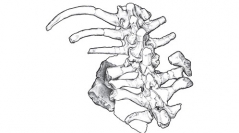

 Geodiversitas
33 (2) - Pages 227-246
Geodiversitas
33 (2) - Pages 227-246The description of a new large caseid, Ruthenosaurus russellorum n. gen., n. sp. from the Early Permian (upper Cisuralian to lower Lopingian) of the Rodez Basin, France, is based on a partial postcranial skeleton that was initially collected at the same time as the holotype of "Casea" rutena Sigogneau-Russell & Russell, 1974. Despite its distinctly larger size than "C." rutena, the holotype of Ruthenosaurus n. gen. clearly represents an immature individual, as shown most clearly by the lack of fusion of the neural arches to their respective vertebral centra and incomplete ossification of the ends of the limb elements, including the absence of an ossified olecranon on the ulna. Nonetheless, Ruthenosaurus n. gen. is diagnosed by several autapomorphic characters, including dorsal vertebrae with anteriorly tilting neural spines and a diamond-shaped outline in transverse section, a first sacral rib with a dorsoventrally expanded distal head, and a low iliac blade with a poorly developed anterior process. The new taxon is further distinguishable from the only other known French caseid, “Casea” rutena, by the shape of the distal part of the humerus, including an ectepicondylar notch rather than a fully enclosed foramen, the specific shape of the ulna, and the overall robustness of the specimen. The taxonomic status of "Casea" rutena is discussed and it is concluded that this species should be moved into a new genus named Euromycter n. gen. The occurrence of the large-sized Ruthenosaurus n. gen. in France increases our knowledge about the early diversity of this clade in Europe.
Synapsida, Caseasauria, Caseidae, Europe, France, Permian, new genera, new species